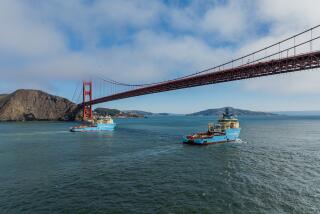Malaysia plane: Confronting searchers is an ocean full of garbage

BEIJING -- The search and rescue teams working off the west coast of Australia seeking the missing Malaysia Airlines Flight 370 discovered what oceanographers have been warning: Even the most far-flung stretches of ocean are full of garbage.
For the first time since the search focused on the south Indian Ocean 10 days ago, the skies were clear enough and the waves calm, allowing ships to retrieve the “suspicious items” spotted by planes and on satellite imagery.
But examined on board, none of it proved to be debris from the missing plane, just the ordinary garbage swirling around the ocean.
“A number of objects were retrieved by HMAS Success and Haixun 01 yesterday,’’ reported the Australian Maritime Safety Authority in a release Sunday. “The objects have been described as fishing equipment and other flotsam.’’
The disappointing results underscored the difficulty the search teams face trying to find out what happened to the Boeing 777 and its 239 passengers and crew. The plane disappeared March 8 during a flight from Kuala Lumpur to Beijing.
Australian authorities said Sunday that a naval support ship, the Ocean Shield, will depart from Perth on Monday with a “black box detector” supplied by the U.S. Navy. The Towed Pinger Locator 25 is towed behind the ship and carries a listening device that should be able to detect the black boxes of the plane in waters as deep as 20,000 feet.
The search team is in a race against time because black boxes’ batteries last only 30 to 45 days. The odds are stacked against finding them in time without a trail of debris to guide them. Investigators for now are merely surmising that the flight crashed into the Indian Ocean, based on an analysis of the flight’s path according to engine data transmitted via satellite.
The best-known precedent is the case of Air France Flight 447, which crashed over the Atlantic on a flight from Rio de Janeiro to Paris in 2009. It took two years to find the body of the aircraft and the black boxes, which recorded pilots’ conversation and data, even though pieces of debris were found within five days.
The south Indian Ocean is one of the most remote places on the planet, far from any islands, shipping lanes or flight paths. But the area accumulates surprisingly large amounts of garbage, trapped in the gyre of slowly rotating currents.
“In addition to foul weather, administrative bungling and the vastness of the search area, the search for MH 370 has been compounded by one other factor: the incredible amount of garbage already floating in the search area — and in oceans worldwide,’’ wrote Marc Lallanilla on the website, livescience.com, where he referred to the search for Flight 370 as a “needle in a garbage patch.’’
The lack of confirmed debris has prevented families from achieving any kind of closure over the deaths of their relatives. Chinese families, in particular, have rejected the assertion of the Malaysian government that the plane crashed with no survivors.
“We want evidence, truth and dignity,’’ read banners that Chinese relatives held at an impromptu demonstration at a Kuala Lumpur hotel on Sunday.
Malaysia Airlines said Sunday that it will fly families of passengers to Perth and will set up a family assistance center to providing counseling and logistical support, but will do so “only once it has been authoritatively confirmed that the physical wreckage found is that of MH370.’’
[For the record at 4 p.m. PDT on March 30: An early version of this post incorrectly referred to a Towered Pinger Locator 24 device. It is called a Towed Pinger Locator 25.]
Twitter: @barbarademick
More to Read
Sign up for Essential California
The most important California stories and recommendations in your inbox every morning.
You may occasionally receive promotional content from the Los Angeles Times.










